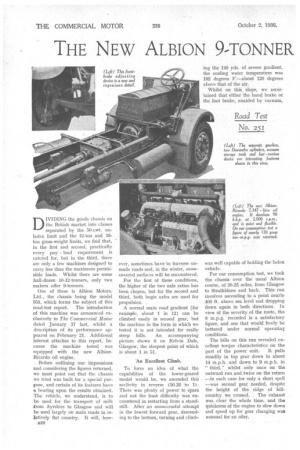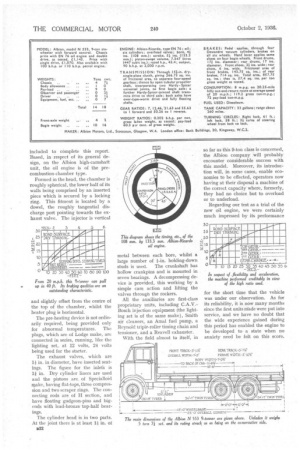THE i\ EW ALBION 9-TONNER
Page 30

Page 31

Page 32

If you've noticed an error in this article please click here to report it so we can fix it.
3RIDGES THE GAP ADEQUATELY
This Chassis of Uncommon• Rating, Powered by the Maker's Own Oil Engine, Proves Itself a Worthy Addition to the Popular Albion Range DIVIDING the goods chassis on the British market into classes separated by the 50-cwt. unladen limit and the 12-ton and 19ton gross-weight limits, we find that, in the first and second, practically every pay load requirement is catered for, but in the third, there are only a few machines designed to carry less than the maximum permissible loads. Whilst there are some half-dozen 10-12-tonners, only two makers offer 9-tonners.
One of these is Albion Motors, Ltd., the chassis being the model 553, which forms the subject of this road-test report. The introduction of this machine was announced exclusively in The Commercial Motor dated January 17 last, whilst a description of its performance appeared on February 21. Additional interest attaches to this report, because the machine tested was equipped with the new AlbionRicardo oil engine.
Before outlining our impressions and considering the figures returned, we must point out that the chassis we tried was built for a special purpose, and certain of its features have a bearing upon the results obtained. The vehicle, we understand, is to be used for the transport of milk from Ayrshire to Glasgow and will be used largely on main roads in relatively fiat country. It will, how s20 ever, sometimes have to traverse unmade roads and, in the winter, snowcovered surfaces will be encountered.
For the first of these conditions, the higher of the two axle ratios has been chosen, but for the second and third, both bogie axles are used for propulsion.
A normal main road gradient (for example, about 1 in 12) can be climbed easily in second gear, but the machine in the form in which we tested it is not intended for really steep hills. An accompanying picture shows it on Kelvin Dale, Glasgow, the steepest point of which is about 1 in 5.
An Excellent Climb.
To form an idea of what the capabilities of the lower-geared model would be, we ascended this acclivity in reverse (50.26 to 1). There was plenty of power to spare and not the least difficulty was encountered in restarting from a standstill. After an unsuccessful attempt in the lowest forward gear, descending to the bottom, turning and climb ing the 140 yds. of severe gradient. the cooling water temperature was 192 degrees F.—about 120 degrees above that of the air.
Whilst on this slope, we ascertained that either the hand brake or the foot brake, unaided by vacuum, was well capable of holding the laden vehicle.
For our consumption test, we took the chassis over the usual Albion course, of 20.25 miles, from Glasgow to Strathblane and back. This run involves ascending to a point nearly 400 ft. above sea level and dropping down again in both directions. In view of the severity of the route, the 8 m.p.g. recorded is a satisfactory figure, and one that would freely be bettered under normal operating conditions.
The hills on this run revealed excellent torque characteristics on the part of the power unit. It pulls steadily in top gear down to about 14 m.p.h. and down to 9 m.p.h. in " third," whilst only once on the outward run and twice on the return —in each case for only a short spell —was second gear needed, despite the height of the ridge of hillcountry we crossed. The exhaust was clear the whole time, and the quickness of the engine to slow down and speed up for gear changing was unusual for an oiler. Sharp bends are fairly numerous on this route and, in one place, a partly made roundabout necessitates the rounding of an acute angle. Thus, excellent ,opportunities of demonstrating the first-class road-holding qualities of the machine were afforded. The ease with which it can be swung around such corners at speed is most noteworthy.
Not only its ability to corner, but also its suspension is excellent. Whilst almost free from any tendency to roll, it rides so smoothly that we experienced no difficulty in writing notes, when travelling at 25 m.p.h. Before concluding this summary of our general observations, we must mention that, compared with other oil engines, the noise of the AlbionRicardo is below average.
In comparing other performance features, one is handicapped by reason of the fact already mentioned, that the machine is almost alone in its class. However, we regard the 55 secs required to reach 30 mph. from rest as good, bearing in mind the high axle ratio.
With regard to braking, the variation in stopping distance from 30 m.p.h. does not materially exceed 30 ft. throughout the range of all classes of high-quality modern commercial vehicles. If it be realized that the distance required by this 9-tonner is only 20 ft. longer than that needed by an average lorry of half its pay-load rating ahd permitted to travel 10 m.p.h. faster, the excellence of its braking system will be appreciated.
The Brake Layout.
Four vacuum cylinders are employed. Two mounted on the stub axles apply the front brakes, and two are coupled to the main brake cross-shaft—one at each end to eliminate twisting of the shaft. The arrangement was described in our issue mentioned earlier.
A new feature of the front brakes is the adjustable coupling to the camshafts. This is clearly shown in an accompanying illustration. The bell crank is free on the shaft, the pull being transmitted by the adjustable rod passing through its lower end. Note the alternative positions for the lower end of the rod from the cylinder.
Another ingeniously simple detail in the brake layout is the design of the lost-motion devices in the rear linkage. These, of course, pergnit the use of the hand lever without interference with the foot system and vice versa. They function on the non-reversible hinge principle, As the Albion-Ricardo oil engine has not been previously described, an outline of its main features must be B21 included to complete this report. Based, in respect of its general design, on the Albion high-camshaft unit, the oil engine is of the precombustion-chamber type.
Formed in the head, the chamber is roughly spherical, the lower half of its walls being comprised by an inserted piece which is secured by a locking ring. This fitment is located by a dowel, the roughly tangential discharge port pointing towards the exhaust valve. The injector is vertical and slightly offset from the centre of the top of the chamber, whilst the heater plug is horizontal.
The pre-heating device is not ordinarily required, being provided only for abnormal temperatures. The plugs, which are of Lodge make, are connected in series, running, like the lighting set, at 12 volts, 24 volts being used for the starter.
The exhaust valves, which are 1i in. in diameter, have inserted seatings. The figure for the inlet's is 1i in. Dry cylinder liners are used and the pistons are. of Specialloicl make, having fiat-tops, three compression and two scraper rings. The connecting rods are of H section, and have floating gudgeon-pins and bigends with lead-bronze -top-half bearings.
The cylinder head is. in two parts. At the joint there is at least 1i in. of B22
metal between each bore, whilst a large number of i-in, holding-down studs is used. The crankshaft has hollow crankpins and is mounted in seven bearings. A decompressing device is provided, this working by a simple cam action and lifting the valves through the rockers.
All the auxiliaries are first-class proprietary units, including C.A.V.Bosch injection equipment (the lighting set is of the same make), Smith air cleaners, an Antal fuel pump, a Reynold triple-roller timing chain and tensioner, and a Reavell exhauster.
With the field almost to itself, in so far as this 0-ton class is concerned, the Albion company will probably encounter considerable success with this model. Moreover, its introduction will, in some cases, enable economies to be effected, operators now having at their disposal a machine of the correct capacity where, formerly, they had no choice but to overload or to underload.
Regarding our test as a trial of the new oil engine, we were certainly much impressed by its performance for the short time that the vehicle was under our observation. As for its reliability, it is now many months since the first units niade were put into service, and we have no doubt that the wide experience gained during this period has enabled the engine to be developed to a state when no anxiety need be felt on this score.




















































































